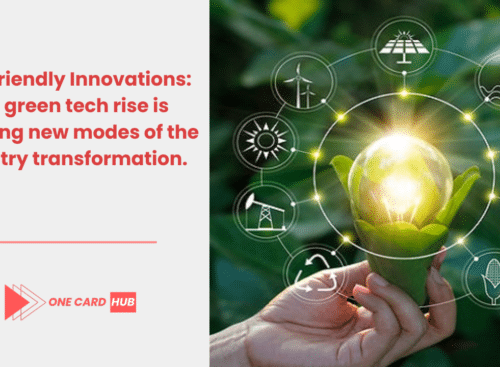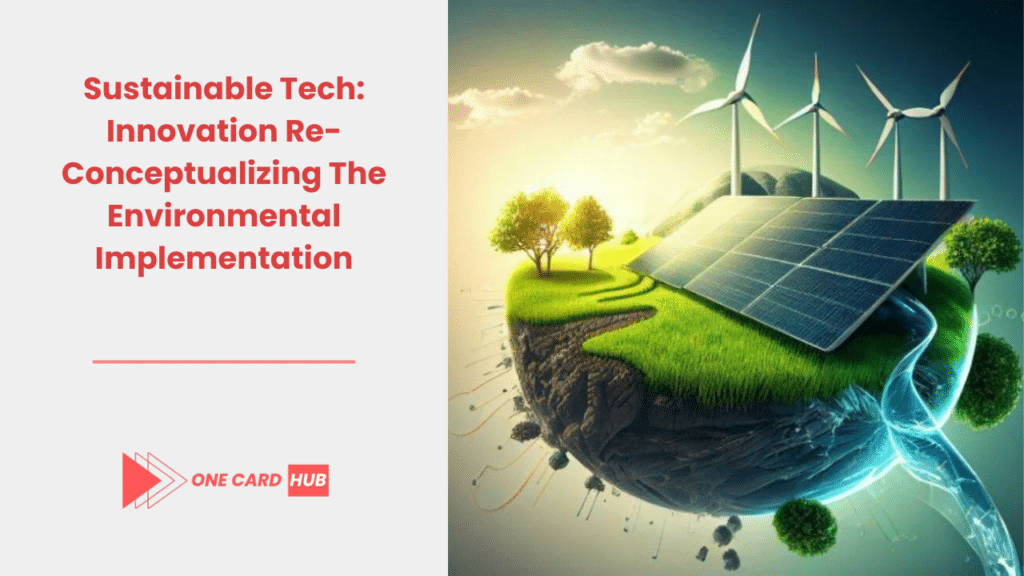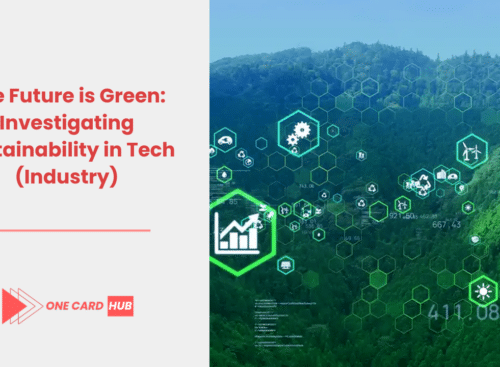What is sustainable tech?
Technologies that are sustainable (sustainable tech) are the ones which have been built and are used putting into consideration minimal or no impact to the environment. Sustainable tech intends to keep the environments effects to a minimum. It encompasses each one of these processes: designing and manufacture, using with caution and disposing at the most, however, things simplified, it (this process) ensures that every step of the way works for the environment.
Why, nothing is more crucial in innovation than redefining environmental responsibility?
Sustainable conversion involvements new characterize as because with traditional innovation may usually comply with convenience, cost, and speed rather than environmental influence. Through embedding sustainability to the innovation process, companies can come up with the products which are not only responding human needs but also are ensuring that environment will remain healthy for the next generations to occupy it.
What role plays the sustainable tech technology in power conservation?
Sustainable tech plays its role in the energy efficiency process in that it is developed to enable devices and systems that either require less energy to perform same tasks or would otherwise be impossible. These comprise energy-saving appliances, data centers, and transportation scenarios which after all is the major factor that reduces the amount of consumed energy.
Despite the significance thrown by the idea of sustainable technologies in challenging the climate change to some extent, it is important to understand that sustainable technologies alone cannot bring any meaningful changes.
Absolutely. The use of cleaner energy sources, including renewables, and the more efficient design of industrial activities and services, contribute to pollution reduction and, therefore, mitigate the effects of global warming. Which having more suggestion that be used effectively to bring out a considerable alteration to an issue.
Thus, what are the specific eco friendly approaches in tech?
Examples are including solar panels, wind turbines, electric vehicles, smart grids, energy-efficient lighting, biodegradable materials, and technologies that are for the swap in and back of products and their recycling.
What is roles of individuals in offering advance and sustainable technology?
People can get involved by first buying eco-friendly products, second advocating for green policies, third reducing the power they consume, and last spreading about how different technologies are contributing to sustainability.
What role do the governments have in promoting the sustainable technology and what kind of impetus can they bring to the table?
Governments can provide a push for eco-friendly technology through the policies that encourage environmentally friendly development, for example, subsidies for green projects, discount or tax exemption for those who use technologies with little hazard to the environment or regulations that require businesses to reduce their negative impact.
Is sustainable tech responding faster, doing more efficient sorting, become smarter in saving energy or even being carbon-free?
At first sight, such sustainables might be purchased for higher price which, however, can be recovered by less expenses spent on their operation and prolonged lifespan. Besides, the fact that sustainable technologies are becoming more common and the cost of which is lower, is leading to lower the costs of them relative to traditional technologies.
What ways do companies use to ensure this sustainable tech in their operations?
The companies are going sustainable by pouring into renewable energy; energy-saving techniques, using eco-friendly materials at products manufacture, and designing the products with maintenance of their life time, which include waste minimization and increased recyclability for healthier environment.
What are the crucial printing blocks hindering the embracing of green technologies?
Some of the hurdles encountered are the initial investment in development and installation, the need to develop or acquire effective technologies to make them more efficient, consumer understanding and adoptions of the green products and, finally, pouring regulatory frameworks.
Probably, the future of sustainable tech will hold a great promise of a world full of green energy and restored environments.
The sustainability of tech is envisioned with exhilarating life, that would be sooner rather than later be realized through continuing innovation and arrival of new technologies which will further minimize the environmental impact. While more people are getting to know about sustainable tech and innovation continues, as a result, sustainable tech is likely to come into vogue. This is the situation where it doesn't exist anymore sharing the stage with environmental sustainability.
Employing the Sustainability Approach by Joining Forces With the Other Sectors
However, the world of sustainable tech is not only innovating tech itself, but also through partnerships which include various sectors. The area of power, transport, farming and building is constantly assuming sustainable technologies which are a proof of the environmental accountability interdependence. It goes without saying that partnerships between tech companies and these areas are of paramount importance since what if met while looking for permanent solutions of global sustainability issues.
The Position of startups and innovative hubs.
Industries such as startups and innovation hubs lead the green technology vista that often show up boots on the ground in emerging technologies that uncork new possibilities. They give rise quickly with their innovativeness and implicity, that’s why they are the key actors that provide new technologies or approaches large corporations and governments can adopt and use. Amongst these ecosystems, the monies, policy and cooperation are necessary to breed the future innovative and environmental friendly technologies.
Education and Workforce Development
In order to achieve sustainable technological innovations, we require skilled human resources with extensive knowledge and expertise in sustainability principles as well as technological aspects. Through comprehensive training of teachers, it is imperative for primary education all the way up to universities to include sustainability into their learning programs. The way to keep developing a pool of environmentally apt individuals that can solve the challenges we are currently facing, is by educating students on green technology and sustainable practices.
Consumer Engagement and Demand
The increasingly conscious consumer demand for ecological products and services constitutes one of the main driving forces for the upgrading of contemporary technologies to the green level. As the community awareness of environmental issues is increasing, cities are being more and more expected in the way be responsible. Consumption people are beginning to demonstrate a policy that aims to acquire their goods and services from companies which have a low impact on the environment. This is a factor that is contributing to the greening of markets.
International trade brings some significant obstacles for boosting sustainability.
The spread of the eco-tech in mailstream is still early but a few obstacles lie between the expansion and the fixing at the global level. Example of these issues is limiting technologies, high cost of changing the supply chain to sustainable operations, and huge infrastructure changes that are required. Conquering the above-stated hurdles entails a long-term investment in the fields of: research & development, policy support and the private sector partnerships with the public sector.
Significance of Policy Makers and Rule Makers.
Efficient policy and regulation are a prerequisite, however, to that fast-paced adaptation to the green technologies. The government, which is in possession of such powers as the setting standards; providing incentives; and creating conditions that are conducive to green technologies’ development and adoption, is capable of shaping such an environment. Though Renewable energy, energy efficiency, and circular economy policies can crank up the speed to meet the sustainability targets.
Looking Forward: Stabilization of a Sustainability-Influenced Industry
Hence concerning the way to go involves development of a complex environment that supports use and spread of "green tech" on all society's interests. This may also be accomplished by supporting innovation through research and funding, creating policies that promote sustainability, and building infrastructure that increases awareness to and engagement of the public. The technology advancement is soaring to the threshold; consequently, its role in addressing environmental challenges will not be overlooked and will be opened to new avenues for a prosperous green living for one and all.
The advent of the sustainable technology signifies a promising vision of the future, where the tech delivers humans ever higher level of capabilities and does it in a predictable concert with the planet. As the tech industry integrates the fundamentals of sustainability, it will become the vanguard of green transformation, reinventing the concept of ecologically responsible and advanced products which leads to redefining of the world for both the future and current generations.
Combination sustainable tech concepts in design and lifetime towards a sustainable sustainable development.
The adoption of sustainable tech can be promoted and scaled by the integration of the sustainability objectives at the final stages of technology design process while making these products. Such life cycle assessment is all about thinking about sustainability before the design begins by considering the effect of a product on the environment throughout its whole life and involves material selection and manufacturing as well as use and disposal at the end. Designing devises that is recyclable, has superior energy efficiency, and has a greater long life span can reduce the ecological footprint.
Big Data and Analytics as an environmental Insight-Based Tool.
Pelat big data dan analytics menjadi instrumen paling berguna dalam mensgolitikan dan memberikan imvokisi perubahan kamar lingkungan. Companies can also see how much resources they use, which ones need saving and ways to minimize emission through the big data analysis and identifying of patterns and opportunities. Using this data-based strategy brings more awareness at the decision-making level and a better adjustment of sustainable practices across operations.
Advancements in Green Infrastructure
The tech industry and the infrastructure that supports it are in constantly changing environments in the process of the evolution. A suite of actors of green infrastructure e.g. efficient green buildings, reliable data centers driven by renewable resources, and sustainable collaborative energy grid systems is pivotal in minimizing environmental impacts in the operations involving digital technologies. Companies are responsible for erecting the infrastructures which are very energy efficient and water conservational and renewable energy sources are also incorporated hence setting a higher standard for sustainable technology development.
The significance of the Consumer Electronics Recycling Programs.
Electronic waste (e-waste) is one of the emerging issues with correspondingly increasing amount of millions of tons generated around the world annually. The IT sector is taking this step for implementing and promoting recycling programs to take back consumer electronics from the market. This is not just a waste reduction but also a recycling of material recovery, which can be used again to create new products, therefore, doubling the efficiency of the economic cycle and cutting the need of newly acquired raw materials.
Disposition to Ecological Stewardship in the course of logistics processments
The environmental environmentalck production of the tech industry is represented from direct operations to the whole supply chain. Nowadays, many businesses are accountable for the supporting of sustainability in whole their supply chains which covers the sources of raw materials from sustainable way to ensuring fair practice in the labor. Through the establishment and promulgation of sustainability norms for their suppliers, the tech industry can magnify its green potential.
Online marketers use social media and influencer marketing to communicate their brands' sustainable efforts.
Digital platforms are acting as new influencers for spread positive messages aimed at environmental conservation. These portals permit the interchange of resources, the transition of goods to services within a circular economy, as well as the important protocol of environmental value dissemination. The coupling of technologies to bring people and organizations together in this manner is also the way by which digital platforms promote the acceptance of these behaviors and innovations.
The factors that stands in the way of sustainable technology does not start and the and problems do not only consist of the deployment of such technologies.
While there has been progress in the operation and application of green tech, its mainstream deployment continues to suffer from some bottlenecks such as technological, economic and regulatory obstacles. To tackle these obstacles, the future innovation is to be made, financial incentives have to be applied and supportive policies must have been set up. Awareness to the public will also be a crucial aspect in the system because they will contribute in ensuring demand for ecologically friendly technologies and ways of doing things.
Observing A Communal Trip Of Sustainability
The path we are taking to a more environmentally responsible tech sector must involve a group effort of many stakeholders, including tech companies, governments, non-governmental organisations and customers. But problems still are quite difficult, nonetheless the power of technology in moving environmental sustainability across the globe is truly great. Through unceasingly fostering innovations, means of sustainability and policy-level campaigns, tech-sector can indeed be the vanguard of a brighter and more sustainable future for everybody. While in the near future we will have to make sure that our focus will stay on inventing new tools to be even more responsible to the environment the only way to achieve it is by continuous innovation.
FAQ: Some of the startup ideas for an eco-friendly startup can include sustainable technologies and taking responsibility for the environment
What is sustainable technology?
Sustainable technologies includes that innovation which is intentionally made in a manner that it would not only reduce at around zero but also the environmental impact of the life span from manufacturing till disposal. However, it provides that the present generations should use resources only at the level that should not leave future generations unable to do the same. It states that resources should be conserved and renewable resources should be put into use.
What is the essence of this “sustainable technology”?
It would contribute to the solution of climate change, decrease pollution, use up fewer resources as well as build a good habit of the people of our country. Sustainability tech provides a new breed of growth strategies, which require minimal or even none consumption of natural resources that will improve the wellbeing of all.
Besides from sustainable technology reducing environmental impact, what are the other effects of such initiatives?
It helps lessen the impact through the application of renewable energy sources, diminishing emissions by recycling and reusing the waste, and achieving higher rankings in energy and resource productivity, as well as the use of environmentally-friendlier materials. They increase the rate of gas absorption and therefore diminish the level of exhaustion of the natural resources.
The technology cost is crucial from among the range of factors that determine the achievement of ecological sustainability.
Definitely, in spite of higher startup costs of some green technologies, they result in lower energy consumption, less-servicing costs, and lower waste volumes, which consequently reduces the cost in the long run. Besides, with the rise of demand and production, the prices of environmental technologies are also in the trend of lowering their costs.
What role does people play in pushing the world towards the technology which is green?
There are a number of ways that the individuals can support to the development of green technology such as buying sustainable products, conserving energy, supporting green policies, and sensitizing public about the value of sustainability. The purchase behavior of consumers has companies offering eco-friendlier products as the priority.
What kinds of mechanisms can companies adopt into their operations to realize eco-friendly technology?
Organizations can embed sustainable technology by purchasing renewable energy, implementing energy-saving techniques, using sustainable materials, designing products thoughtfully with long life and recyclability in mind, and of course, by committing to sustainable supply chains.
What are the challenges that face sustainable technologies in their realization?
Difficulties like high initial costs, low awareness on the part of consumers, technological restrictions, and no support from the polices and regulations can make it hard to introduce this technology into transport sectors. Beating this catch 22 need strongly concerted actions of the governments, companies and people.
What is globally viable technology for sustainable growth?
The recent steps towards leading factors in the transition make the future look promising as the renewable energy, materials science and digital technologies gradually set its course towards sustainability. With improved understanding and cooperation awareness and commitment to sustainable technology will grow and sustainable technology will be mainstream and will gradually shape the world economy that will become more sustainable and environment friendly.
The government measures do their best by increasing investment in research and development, setting a standard and imposing regulations for environmental protection, giving tax breaks and subsidies for the projects connected with sustainable development, and investing in sustainable infrastructure. These policies facilitate the manufacturing of green technology creating a conduce atmosphere for its growth.





Related posts